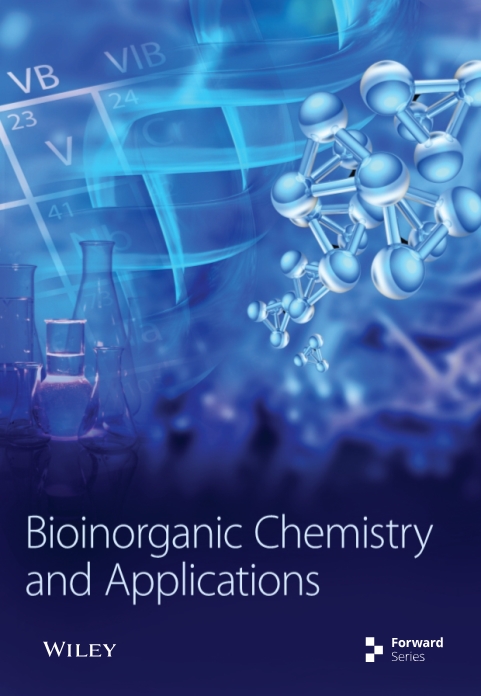A Nanostructured Cu(II) Coordination Polymer Based on Alanine as a Trifunctional Mimic Enzyme and Efficient Composite in the Detection of Sphingobacteria
IF 4.7
3区 化学
Q1 BIOCHEMISTRY & MOLECULAR BIOLOGY
引用次数: 0
Abstract
This research raises the potential use of coordination polymers as new useful materials in two essential research fields, allowing the obtaining of a new multiartificial enzyme with the capacity to inhibit the growth of bacteria resistance. The fine selection of the ligands allows the design of a new 2D coordination polymer (CP), with the formula [Cu2(IBA)2(OH2)4]n·6nH2O, by the combination of Cu (II) as the metal center with a pseudoamino acid (H2IBA = isophthaloyl bis β-alanine). Quantitative total X-ray fluorescence (TXRF) analyses show that the obtained CP can gradually release Cu (II) ions. Additionally, this CP can be nanoprocessed and transformed into a metal-organic gel (MOG) by using different Cu (II) salt concentrations and the application of ultrasounds. Considering its nanometric dimensions, the slow Cu (II) release and its simple processability, its performance as an artificial enzyme, and its antibacterial ability were explored. The results obtained show the first nanocoordination polymer acting as an artificial multienzyme (peroxidase, catalase, and superoxodismutase) exhibiting antibacterial activity in the presence of hydrogen peroxide, with selective behavior for three bacterium strains (S. spiritovirum, A. faecales, and B. cereus). Indeed, this CP shows a more robust inhibition capacity for Sphingobacterium. Going beyond that, as there are no comfortable and practically clinical tests capable of detecting the presence of Sphingobacteria, the compound can be easily embedded to form moldable gelatin that will facilitate the handling and low-cost commercial kits.基于丙氨酸的三功能模拟酶纳米结构Cu(II)配位聚合物及其高效复合物在鞘细菌检测中的应用
本研究提出了配位聚合物作为新的有用材料在两个重要研究领域的潜在用途,允许获得一种新的具有抑制细菌耐药性生长能力的多人工酶。通过对配体的精细选择,以Cu (II)为金属中心与假氨基酸(H2IBA =异酞酰二β-丙氨酸)结合,设计了一种新的二维配位聚合物(CP),其分子式为[Cu2(IBA)2(OH2)4]n·6nH2O。定量全x射线荧光(TXRF)分析表明,所得CP能逐渐释放Cu (II)离子。此外,该CP可以通过不同的Cu (II)盐浓度和超声波的应用进行纳米加工并转化为金属有机凝胶(MOG)。考虑到其纳米尺寸,对其Cu (II)释放缓慢、加工简单、作为人工酶的性能及抗菌性能进行了探讨。结果表明,纳米配位聚合物作为人工多酶(过氧化物酶、过氧化氢酶和超氧化物歧化酶)在过氧化氢存在下表现出抗菌活性,对三种细菌菌株(灵链球菌、粪链球菌和蜡样芽孢杆菌)具有选择性。事实上,这种CP对鞘菌具有更强的抑制能力。除此之外,由于没有舒适和实际的临床测试能够检测鞘菌的存在,该化合物可以很容易地嵌入形成可塑明胶,这将有利于处理和低成本的商业套件。
本文章由计算机程序翻译,如有差异,请以英文原文为准。
求助全文
约1分钟内获得全文
求助全文
来源期刊

Bioinorganic Chemistry and Applications
化学-生化与分子生物学
CiteScore
7.00
自引率
5.30%
发文量
105
审稿时长
>12 weeks
期刊介绍:
Bioinorganic Chemistry and Applications is primarily devoted to original research papers, but also publishes review articles, editorials, and letter to the editor in the general field of bioinorganic chemistry and its applications. Its scope includes all aspects of bioinorganic chemistry, including bioorganometallic chemistry and applied bioinorganic chemistry. The journal welcomes papers relating to metalloenzymes and model compounds, metal-based drugs, biomaterials, biocatalysis and bioelectronics, metals in biology and medicine, metals toxicology and metals in the environment, metal interactions with biomolecules and spectroscopic applications.
 求助内容:
求助内容: 应助结果提醒方式:
应助结果提醒方式:


